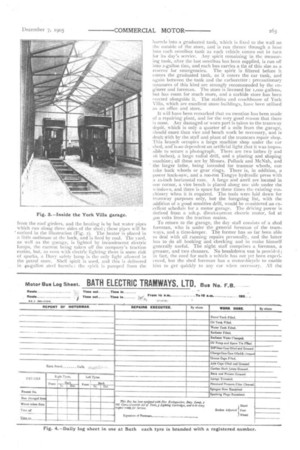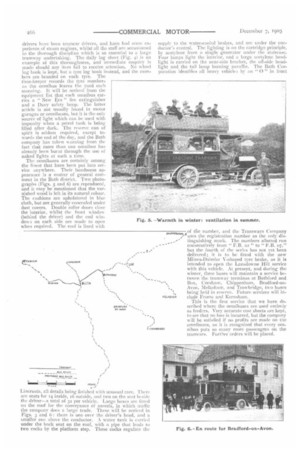Public Service Garages (No. IV).—Bath.
Page 8

Page 9

Page 10

If you've noticed an error in this article please click here to report it so we can fix it.
How the Motor Omnibus is Being Utilised by an Electric Tramway Company.
The Bath Electric Tramways, i.itnited, was formed to take over horse tramways in the City of Bath, in order to reconstruct the track for electric traction, and for the purpose of extending the lines into the suburbs. The original track taken over in 1901 was only one mile in length of single track, to which another to miles of single and 4,1 miles of double track were added, bringing the total to x5L, route miles. After these lines were opened, the company found that there were still several districts, like Lansdowne and Whitcombe, which they had promised to serve. It was considered that the gradient of Lansdowne Hill was too steep for tramways, and that the traffic on the other promised routes was unlikely to be sufficient to justify the heavy capital expenditure on permanent way construction and overhead equipment. The decision to experiment with motor omnibuses for these routes was then taken, and six double-deck omnibuses were ordered from Milnes-Daimler, Limited, in 1905, the first of which was delivered in August, whilst the last is expected this month, Every square foot of space was already occupied at the tramway depOt, and it became necessary to arrange for a garage elsewhere. The company holds itself fortunate in haying been able to secure an old house known as York Villa, located in the centre of the city, and having large grounds, but which had re_ mained unlet in consequence of its proximity to the river. There was never any doubt that this area ‘vould be of great value to the company in the near future for tramway sheds, though the house is being prepared for temporary occupation by the resident engineer. It is in what had been the kitchen garden, which is shown as a ground plan in Fig. T , that a corrugated iron shed (Fig. 2) has been erected, and this building is designed to accommodate eight omnibuses. As the site in its old condition was liable to be flooded during the winter months,. it had to be made up to the road leVel, and sub-soil percolations have caused the concrete floor to sink in places already, but there is now no occasion to fear further settlement. The building by-laws of Bath require that a clear space of 30 feet shall be left outside a corrugated iron building ; but when a permanent brick structure is built it may extend to the boundaries of any site. A long pit, which will be Z■C:711
in Fig. 3, extends longitudinally down the shed. It is constructed with brick walls, and is crossed by steel joists of 8 inches by 6 inches section, at intervals of 6 feet. These joists have proved excellent as bases from which to jack up the axles or frames while repairs are in hand, and this is a feature which should be copied. The edges of the pit arc protected by angle irons, one web of which is bedded in the concrete, and the angles come together at a point in front of the pit, so as to guide the wheels into their proper tracks when the omnibuses are being backed into position. There is a convenient vice bench at the end of the garage.
The lighting, by incandescent electric lamps, is entirely
from the roof girders, and the heating is by hot water pipes which run along three sides of the shed ; these pipes will be noticed in the illustration (Fig. 2). The heater is placed in a little outhouse at the back, and is fired by coal. The yard, as well as the garage, is lighted by incandescent electric lamps, the current being taken off the company's traction mains, but, as even with electric lighting there is some risk of sparks, a Davy safety lamp is the only light allowed in the petrol store. Shell spirit is used, and this is delivered in 40-gallon steel barrels : the spirit is pumped from the
barrels into a graduated tank, which is fixed to the wall on the outside of the store, and is run thence through a hose into each omnibus tank as each vehicle comes out in turn for its day's service. Any spirit remaining in the measuring tank, after the last omnibus has been supplied, is run off into 2-gallon tins, and each bus carries a tin of this size as a reserve for emergencies. The spirit is filtered before it enters the graduated tank, as it enters the car tank, and again between the tank and the carburetter : precautionary measures of this kind are strongly recommended by the engineer and foreman. The store is licensed for x,000 gallons, but has room for much more, and a carbide store has been erected alongside it. The stables and coachhouse of York Villa, which are excellent stone buildings, have been utilised as an office and store.
It will have been remarked that no mention has been made of a repairing plant, and for the very good reason that there is none. Any damaged or worn part is taken to the tramway depot, which is only a quarter of a mile from the garage, s:hould more than vice and bench work be necessary, and is dealt. With by the staff and plant of the tramcars repair shop. This branch occupies a large machine shop under the car shed, and is o4o dependent on artificial light that it was impossible to secure a photograph. There are two lathes (7 and 16 inches), a large radial drill, and a planing and shaping machine; all these are by Messrs. Pollack and McNab, and the larger lathe, being intended for tramcar wheels, can take back wheels or gear rings. There is, in addition, a power hack-saw, and a too-ton Tangye hydraulic press with it to-inch horizontal ram. A forge and anvil are located in one corner, a vice bench is placed along one side under the windows, and there is space for three times the existing machinery when it is required. The tools were laid down for tramway purposes only, but the foregoing list, with the addition of a good sensitive drill, would be considered an excellent schedule for a motor garage. The driving power is derived from a toh.p. direct-current electric motor, fed at soo volts from the traction mains.
To return to the garage, the day staff consists of a shed foreman, who is under the general foreman of the tramways, and a thne-keeper. The former has so far been able to deal with all running repairs personally, and the latter has to do all booking and checking and to make himself generally useful, The night staff comprises a foreman, a greaser, and two cleaners. No breakdown van is provided ; in fact, the need for such a vehicle has not yet been experi'Awed, but the shed foreman has a motor-bicycle to enable him to get quickly to any car when necessary. All the
The omnibuses are. certainly among the finest that have been put. into service anywhere. Their handsome appearance is a matter of general comment in the Bath district. Two photographs (Figs. 5 and 6) are reproduced, and it may be mentioned that the varnished wood is left in its natural colour. The cushions are upholstered in blue cloth, but are generally concealed under dust covers. Double roller doors close the interior, whilst the front window (behind the driver) and the end windows on each side are made to open when required. The roof is lined with
Lincrusta, all details being finished with unusual care. There are seats for ri inside, 16 outside, and two on the seat beside the driver—a total of 32 per vehicle. Large boxes are fitted on the roof for the conveyance of parcels, in which traffic the company does a large trade. These will be noticed in Figs. 3 and 6 : there is one over the driver's head, and a smaller one above the conductor. .1 water tank is carried under the back seat on the roof, with a pipe that leads to two cocks by the platform step. These cocks regulate the supply to the water-cooled brakes, and are under the conductor's control. The lighting is on the cartridge principle, by acetylene from a single generator under the staircase. Four lamps light the interior, and a large acetylene headlight is carried on the near-side bracket, the off-side headlight and the tail lamp burning paraffin. The Bath Corporation identifies all heavy vehicles by an " 0 " in front
of the number, and the Tramways Company
/PMVHArd, 4
uses the registration number as the only tinguishing mark. The numbers allotted run
_ consecutively from " F.B. 02 " to " F.B. 07," but the fourth of the series has not yet been delivered; it is to be fitted with the new "Mfines-Daimler V-shaped tyre brake, as it is intended to open the Lansdowne Hill service with this vehicle. Al present, and during the winter, three buses will maintain a service between the trarnwav terminus at Bathford and Box, Corsham, -Chippenham, Bradford-onAvon, Melksham, and Trowbridge, two buses being held in reserve. Future services will include Frome and Kernshatn.
This is the first service that we have described where the omnibuses are used entire:3:as feeders. Very accurate cost sheets are kept, to see that no loss is incurred, but the company will be satisfied if no profits are made on the omnibuses, as it is recognised that every omnibus puts so many more passengers on the tramcars. Further orders will be placed.






















